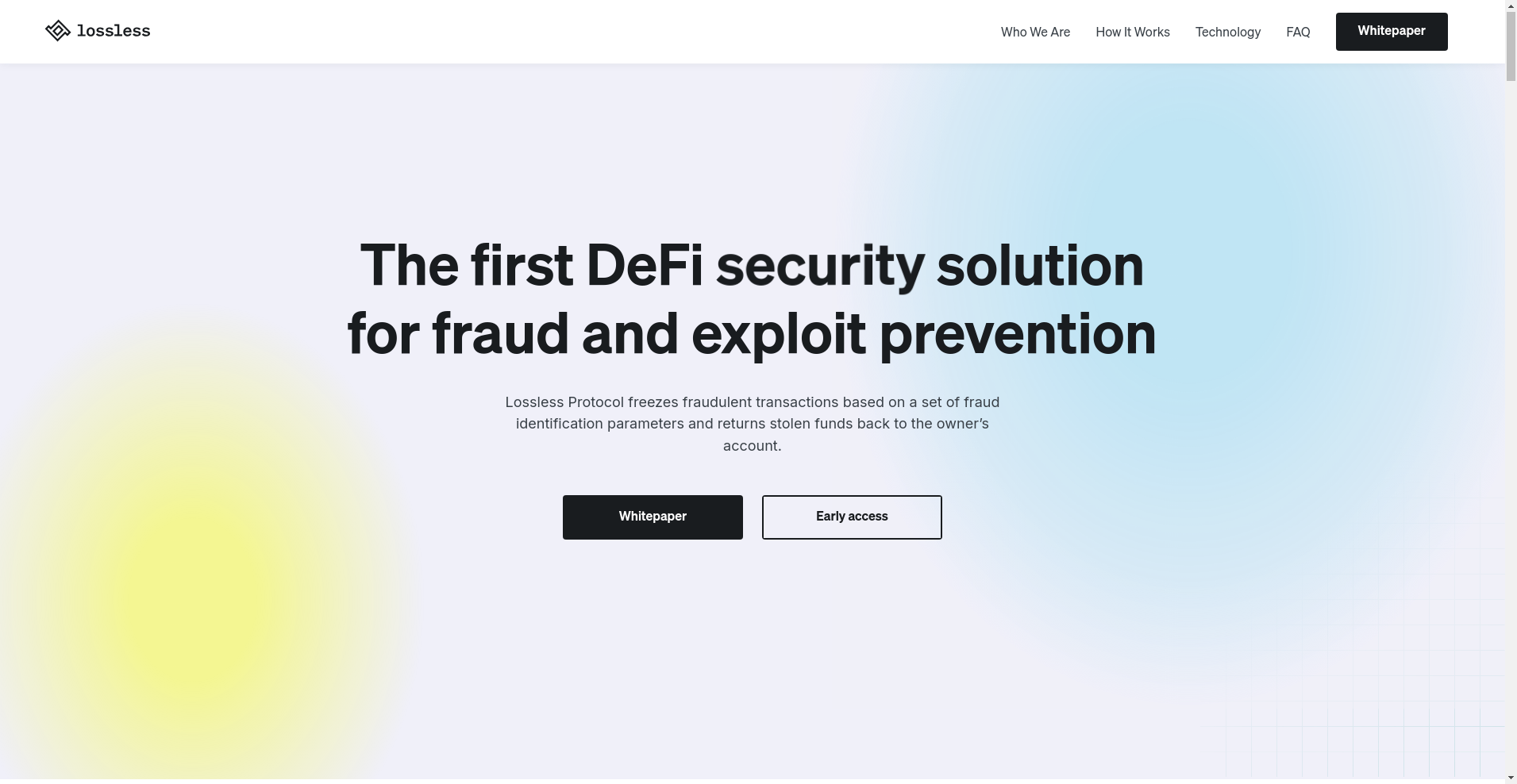Lossless ($LSS) Review: A Data-Driven Examination of Its Legitimacy, Security, and Risks

What Is Lossless: An Introduction
Lossless ($LSS) is a decentralized finance (DeFi) security protocol designed to protect digital assets from hacks, exploits, and fraudulent transactions. Its core proposition revolves around enabling projects and token holders to detect malicious activities in real time and to initiate rapid mitigation actions, primarily through transaction freezing and fund recovery.
The platform employs a combination of blockchain monitoring, automated hack detection tools, and a community-driven committee to scrutinize suspicious activities. This multi-layered approach aims to bolster trust and security within the DeFi ecosystem by preventing losses before they occur or mitigating damages swiftly.
This review provides an impartial, evidence-based analysis of Lossless’s strengths, potential vulnerabilities, and overall legitimacy based on available audit reports, project data, and ecosystem activity.
The Team and Vision Behind Lossless
Lossless appears to operate with a mix of known auditors and decentralized community involvement. Specific details about the core team members are limited; the publicly available information references an advisory and oversight body, yet individual team member backgrounds are not extensively documented in open sources. The project emphasizes community participation in hack detection and validation processes, suggesting a hybrid approach that leverages open collaboration rather than solely relying on centralized leadership.
Assessing the roadmap, Lossless has set clear milestones, including:
- Q1 2025: Proof-of-Concept development, initial security audits.
- Q2 2025: Establishment of Lossless committee, public security audits, and formalization of governance structures.
- Q3 2025: Launch of the Lossless platform with hack monitoring toolkit, token governance, and wider integration.
- Q4 2025: Roll-out of advanced features such as token relaunch toolkit and support for additional blockchains like BSC and DOT.
Based on this outline, Lossless shows a structured plan with achievable milestones, but the success depends heavily on executive execution and community engagement, which remains somewhat opaque at present.
Assessing the Security and Integrity of Lossless
The security analysis is primarily based on the audit reports from Hacken and Certik, two reputable cybersecurity firms within the blockchain space. According to Cer.live, Lossless underwent comprehensive audits, with a platform rating of approximately 5.15 out of 10 and a rank of 411, reflecting moderate visibility and market adoption.
Key findings from the audit reports include:
- Audits Conducted by Reputable Firms: Both Hacken and Certik independently evaluated the Lossless platform, covering smart contract logic, security vulnerabilities, and process integrity.
- Incident History: The audit notes that incidents occurred prior to the review, which suggests points of concern, though immediate vulnerabilities appear to have been addressed in subsequent audits.
- Vulnerabilities Identified: The details of specific technical vulnerabilities are not publicly disclosed in the summary, but the presence of active bug bounties indicates ongoing vulnerability management.
- Insurance and Risk Management: The platform currently lacks formal insurance coverage, suggesting that losses due to unforeseen exploits could still impact users or projects relying solely on Lossless. This highlights the impact of no insurance in DeFi security.
- Audit Scope and Coverage: The audits cover core components but may not fully extend to all integrations or future developments, emphasizing the need for continuous security updates.
While the audits from credible firms support the platform’s security posture, the absence of full insurance coverage and the limited public disclosure of specific vulnerability mitigation details mean that some residual risk remains for participants.
A Breakdown of Lossless Tokenomics
The Lossless token ($LSS) has a total supply of 100 million tokens, with a circulating supply of approximately 68.5 million, and a current market cap of just under $1.2 million. Its utility encompasses governance participation, staking, reward distribution, and incentivizing bug bounty contributions.
Key tokenomics features include:
- Total Supply: 100,000,000 LSS, fixed and capped.
- Market Cap & Price: Around $1.19 million, with a trading price of approximately $0.0173 per token.
- Allocation Breakdown:
- Team & Founders: Not publicly specified; likely a proportion of tokens vested over time.
- Community & Ecosystem: Significant portion allocated for staking rewards, bug bounties, and development incentives.
- Venture Capital & Early Investors: Not clearly disclosed, which is a concern for transparency.
- Vesting & Lock-up: Details are scarce; transparency around vesting schedules is critical for assessing long-term sustainability.
- Utility and Incentives: Governance participation, community rewards, security staking, and incident response incentives.
The economic model hinges on maintaining network security and incentivizing active community involvement. However, the relatively low market capitalization combined with a limited liquidity base indicates potential volatility and susceptibility to pump-and-dump schemes. Understanding how to manage these risks is key, and readers can learn more about risk mitigation strategies for low market cap tokens. Additionally, the lack of comprehensive disclosures about token distribution and vesting schedules presents governance transparency risks for prospective holders.
Assessing Lossless's Development and Ecosystem Activity
Recent activity suggests active development, with multiple audits completed by firms like Hacken and Certik leveraging rigorous testing frameworks. The project’s roadmap indicates a focus on platform stability, community governance, and cross-chain support, which are important factors for ecosystem growth.
Despite promising technical milestones, distinct signs of progress in real-world deployment are limited. The platform’s integration with over 60 DeFi projects and protected assets exceeding $100 million point to a growing user base. However, the frequency and depth of development activity—such as code commits, feature releases, or bug fixes—are less visible externally, making it challenging to fully assess continuous progress versus hype marketing.
Overall, the ecosystem appears to be in a constructive phase, but sustained developer engagement and transparent update reporting are necessary to establish genuine traction and long-term viability.
The Fine Print: Analyzing Lossless's Terms
From the publicly available documentation, Lossless’s terms and conditions emphasize community involvement in fraud validation and funds recovery. Notably, the protocol relies heavily on a community or committee-driven approach, which introduces both inclusiveness and centralization concerns.
Potential risk factors include:
- Limited Liability & Insurance: The absence of formal insurance implies that users cannot easily recover losses outside the protocol's internal processes.
- Vague Governance Details: Without clearly defined governance details or voting mechanisms, decision-making could be susceptible to centralization or manipulation.
- Ambiguous Dispute Resolution: The criteria for validating hacks or fraudulent transactions are not fully detailed, which could lead to disputes or inconsistent decisions.
- Regulatory Risks: The decentralized and community-centric model may face evolving regulatory scrutiny depending on jurisdictional enforcement.
In sum, while Lossless promotes transparency and community participation, some clauses and operational ambiguities could pose risks to investors or project stakeholders.
Final Analysis: The Investment Case for Lossless
Lossless presents an innovative approach to DeFi security by combining community-driven fraud detection with an automated mitigation system. Its audits from reputable firms and active ecosystem development lend credibility, yet the project also exhibits certain vulnerabilities: limited disclosure on team structure, a relatively small market cap, and the absence of formal insurance coverage heighten inherent risks.
From a legitimacy standpoint, the audits and technical focus underpin its credibility; however, transparency deficits and the reliance on community validation processes warrant caution. Its tokenomics suggests a carefully designed incentive system, but the lack of detailed vesting schedules and venture disclosures limits clarity on long-term sustainability. The project also relies on incentivizing helpful contributions, potentially through mechanisms like reputation-based bug bounties.
In terms of risks, potential safety concerns include low market liquidity, unproven scalability, and regulatory uncertainties. Conversely, if Lossless successfully executes its roadmap, maintains strong audit security, and fosters active community participation, it could serve as a valuable layer of protection for DeFi projects and investors alike.
Prospective holders should weigh these strengths and weaknesses carefully, recognizing that although Lossless aims to address critical DeFi security needs, it remains a relatively nascent project with inherent risks typical of early-stage blockchain ventures. Thorough due diligence and ongoing monitoring are recommended before considering any involvement.

Sarah Wilson
Offensive Security Engineer
I'm a professional "white-hat" hacker. I think like an adversary to find holes in crypto projects before the bad guys do. My job is to break things so you don't get broken.
Similar Projects
-
cowbaby
cowbaby Review: Scam Check & Legitimacy Analysis of a Failed Crypto Project
-
$Pepper Project
Review of $Pepper Project: Crypto Scam Checker
-
Shelter of Exiles
Comprehensive Review of Shelter of Exiles: Is This Crypto Project a Scam or Legit?
-
Crybaby ($CRYBB)
Crypto Scam Checker Review: Is Crybaby ($CRYBB) a Safe Project or Scam?
-
Kibb.io
Crypto Project Review: Is Kibb.io a Legitimate Platform or Scam? | Crypto Scam Checker